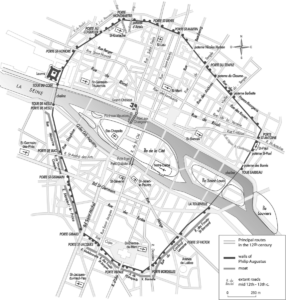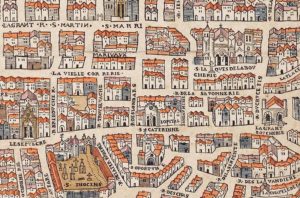
History
Rue des Lombards takes its name from the Lombard money changers who settled there in the 13th century. It was completely built in 1250. In 1300, it was called “rue de la Buffeterie”.
It is quoted in The Tales of the Streets of Paris, Guillot de Paris, under the name of “rue de la Buffeterie”, “Buffet” meaning, in old French, wine merchant.
Its current name was given to it in 1322, when the Lombards – merchants, bankers and usurers, settled in the neighborhood, including the Tolomei family. Lombards being known for their sense of commerce, this term had become synonymous with usurer :
“God keep me four houses,
From the tavern, Lombard,
From hospital and prison. “
– Gabriel Meurier, Treasure of Sentences , 16th century.
From 1612 to 1636, it is named “Rue de la Pourpointerie” and its residents included cutters who made doublets, male clothing.
In 1877 rue de Aiguillerie, located between rue Saint-Denis and rue Sainte-Opportune, is annexed to the street of Lombards.
A ministerial decision of 18 Vendemiaire year VI () signed Letourneux sets the smallest width of this public road to 10 meters. This width is increased to 13 meters, by virtue of a royal ordinance of July 19, 1840.

Remarkable buildings and places of memory
The Janitor of No. 8 is on February 13 1831 the probable first death in Paris of the second pandemic of cholera that will kill in 18 months 18 402 people.
At No 10 the Splendid troupe (Christian Clavier, Michel Blanc , Gérard Jugnot, Thierry Lhermitte, Josiane Balasko, Marie-Anne Chazel, Bruno Moynot and Claire Magnin) settled in 1974.
No 12: Door next to the Ymage Nostre Dame.
No. 14: bore as sign The Ymage Nostre Dame, with a medieval cellar and an underground chapel, is steeped in history. It was built in the 13th century by the powerful order of the Knights Templar with the aim of making it a site of financial and commercial exchanges. It also served as a temporary hiding place for Ravaillac before he was arrested for the murder of Henri IV at 13 rue de la Ferronnerie, a street parallel to rue des Lombards. During the Revolution finally the chapel would have served as a gathering place for secret masses of the clergy.
No. 20: the ground floor was from 1970 to 1973 the Paris headquarters of the New Order movement.
At the corner of 33 bis and 20 rue Saint-Denis was Sainte-Catherine Hospital.
No. 39: it is there that died of phthisis, February 12 1831 the famous songwriter and goguettier Emile Debraux.
At No 47, then 57 was established, under the name La Renommée, the confectionery of Nicolas Appert who invented in his workshops in 1795 the process of appertisation.
House of the King’s Weight
This house which was located rue des Lombards, still existed in the early eighteenth century. Stallions or models of weights and measures were deposited there. Until the reign of Louis VII, the kings of France were the only owners of this establishment and the privileges attached to it 8 . The property was then sold to various people before being definitively acquired by the chapter of Notre-Dame who kept it until the Revolution. In 1321, the provost of Paris, on the order he received from the Parliament of Paris, had the weights adjusted to the Mint, then located rue de la Vieille-Monnaie. Three stallions were made, one of which was given to the grocers, and the other two, placed at the Mint and the weight of the king. In 1484, this right was conferred on them by new ordinances. They exercised it with regard to all kinds of merchants; the goldsmiths alone came directly from the mint. The grocers were accompanied, in their visits, by a sword-juror appointed by the provost of Paris, on their presentation. Until 1434, the weights used were only masses of stone, shaped and adjusted. Philip V le Long, by his regulation of 1321, had formed the design of establishing in France one and the same measure. For the expenses of this reform, he proposed a subsidy; the tax could not rise, and the ordinance fell into oblivion. Louis XI later had the same thought; the nobility and the clergy opposed this improvement. By a decree of August 1, 1793, the Convention ordered this uniformity, and by its decree of 18 Germinal Year III (April 7, 1795) fixed the time when it would become obligatory. It is to the learned Prieur of Côte-d’Or that the adoption of the unification of the metric system and the use of the decimal calculus is due.
References
- Jean de La Tynna, topographical, etymological and historical dictionary of the streets of Paris , 1817.
- Félix and Louis Lazare, administrative and historical dictionary of the streets of Paris and its monuments.
- Felix and Louis Lazare, administrative and historical dictionary of the streets of Paris and its monuments , edition of 1844, p. 6 [ read online [archive] ].
- Michelle Zancarini-Fournel , The Struggles and Dreams: a popular history of France from 1685 to the present day , Paris, Editions La Découverte , , 995 p. ( ISBN 9782355220883) , Chapter 7 (“Conquering a New World? (1831-1848)”), p. 251.
- Philippe Marquis, “The excavation of 12, 14, rue des Lombards in Paris ( IVth arr.)”, Cahiers de la Rotonde , Paris-Rotonde de la Villette, No. 21, 1999, p. 1-119 ( ISBN 2-85738-009-7).
- [archive] Albert Cim, “A forgotten: the singer Émile Debraux, king of the goog (1796-1831)”, The Minstrel , p. 284 , September 4, 1909. This weekly published from July 3 to October 9, 1909 a biography of Emile Debraux in 13 episodes [archive], all available on Gallica.
- Jean-Paul Barbier, Nicolas Appert inventor and humanist , ed. Royer, Paris, 1994 and www.appert-aina.com .
- Henri Sauval , History and research of antiquities of the city of Paris.
Bibliography
- Jacques Hillairet , Historical Dictionary of the Streets of Paris , Paris , Les Éditions de Minuit , 1972, 1985, 1991, 1997, etc. ( 1st ed., 1960), 1,476 p. , 2 vols. [ editions detail ] ( ISBN 2-7073-1054-9 , OCLC 466966117 , online presentation [archive] ) .
- Félix and Louis Lazare, administrative and historical dictionary of the streets of Paris and its monuments .
- Jean Lacroix de Marlès, ancient and modern Paris, according to its monuments .
- Henri Sauval , History and research of antiquities of the city of Paris .
- Jean de La Tynna, topographical, etymological and historical dictionary of the streets of Paris , 1817.
See also
